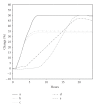Application of an Impedimetric Technique for the Detection of Lytic Infection of Salmonella spp. by Specific Phages
- PMID: 20016810
- PMCID: PMC2789333
- DOI: 10.1155/2009/259456
Application of an Impedimetric Technique for the Detection of Lytic Infection of Salmonella spp. by Specific Phages
Abstract
This study was performed to evaluate the adaption of the impedimetric method to detect the lytic infection by Salmonella-specific bacteriophages and to provide a higher selectivity to this rapid method in detecting Salmonella spp. by using specific agents. Three bacteriophages and twelve strains of Salmonella spp. were tested. Each of the twelve strains was used separately to inoculate TSB together with each one of the phages. The inoculum concentration was between 10(6) and 10(7) cfu/mL, at a cell: phage ratio of 1 : 100. From the sample analysis, based on conductance (G) measurements (37 degrees C), the infection could be detected, by observation of both detection-time delay and distinct curve trends. The main conclusions were that kinetic detection by impedance microbiology with phage typing constitutes a method of determining whether a test microorganism is sensitive to the bacteriophage and a method to evaluate whether a lytic bacteriophage is present in a sample, by affecting bacterial growth rate/metabolic change.
Figures


Similar articles
-
In vitro efficiency evaluation of phage cocktail for biocontrol of Salmonella spp. in food products.Arch Microbiol. 2021 Nov;203(9):5445-5452. doi: 10.1007/s00203-021-02522-0. Epub 2021 Aug 18. Arch Microbiol. 2021. PMID: 34406443
-
Characterization of Salmonella spp.-specific bacteriophages and their biocontrol application in chicken breast meat.J Food Sci. 2020 Mar;85(3):526-534. doi: 10.1111/1750-3841.15042. Epub 2020 Feb 11. J Food Sci. 2020. PMID: 32043599
-
Bio-Control of Salmonella Enteritidis in Foods Using Bacteriophages.Viruses. 2015 Aug 24;7(8):4836-53. doi: 10.3390/v7082847. Viruses. 2015. PMID: 26305252 Free PMC article.
-
The newly isolated lytic bacteriophages st104a and st104b are highly virulent against Salmonella enterica.J Appl Microbiol. 2006 Jul;101(1):251-9. doi: 10.1111/j.1365-2672.2005.02792.x. J Appl Microbiol. 2006. PMID: 16834613
-
Bacteriophages: an overview of the control strategies against multiple bacterial infections in different fields.J Basic Microbiol. 2019 Feb;59(2):123-133. doi: 10.1002/jobm.201800412. Epub 2018 Nov 28. J Basic Microbiol. 2019. PMID: 30485461 Review.
Cited by
-
In Vitro Techniques and Measurements of Phage Characteristics That Are Important for Phage Therapy Success.Viruses. 2022 Jul 7;14(7):1490. doi: 10.3390/v14071490. Viruses. 2022. PMID: 35891470 Free PMC article. Review.
-
Prevention of bacterial foodborne disease using nanobiotechnology.Nanotechnol Sci Appl. 2014 Aug 25;7:73-83. doi: 10.2147/NSA.S51101. eCollection 2014. Nanotechnol Sci Appl. 2014. PMID: 25249756 Free PMC article. Review.
-
Application of Impedance Microbiology for Evaluating Potential Acidifying Performances of Starter Lactic Acid Bacteria to Employ in Milk Transformation.Front Microbiol. 2016 Oct 17;7:1628. doi: 10.3389/fmicb.2016.01628. eCollection 2016. Front Microbiol. 2016. PMID: 27799925 Free PMC article.
References
-
- de Blackburn WC. Rapid and alternative methods for the detection of salmonellas in foods. Journal of Applied Bacteriology. 1993;75(3):199–214. - PubMed
-
- Eden G, Eden R. Enumeration of microorganisms by their dynamic ac conductance patterns. IEEE Transactions on Biomedical Engineering. 1984;31(2):193–198. - PubMed
-
- Yang L, Yanbin L. Detection of viable Salmonella using microelectrode-based capacitance measurement coupled with immunomagnetic separation. Journal of Microbiological Methods. 2006;64(1):9–16. - PubMed
-
- Wawerla M, Stolle A, Schalch B, Eisgruber H. Impedance microbiology: applications in food hygiene. Journal of Food Protection. 1999;62(12):1488–1496. - PubMed
LinkOut - more resources
Full Text Sources
Miscellaneous

